SAS Bundle
Who Really Owns SAS?
Understanding a company's ownership structure is crucial for investors and strategists alike. For SAS, a global leader in analytics and AI software, its private status sets it apart. This exploration will uncover the intricacies of SAS SWOT Analysis, examining its founders, key stakeholders, and potential future ownership shifts.
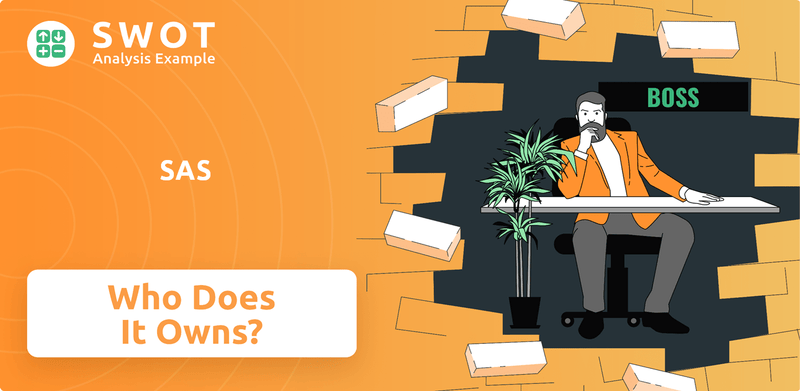
SAS, formally known as SAS Institute, has a unique ownership model that impacts its strategic decisions and market positioning. With its headquarters in Cary, North Carolina, and a history dating back to 1976, the SAS company's journey provides valuable insights into its founders' vision and the evolution of its ownership. Discover the answers to questions like "Who owns SAS?" and "Is SAS a public company?" as we delve into the SAS Institute ownership structure and financial information.
Who Founded SAS?
The origins of SAS Institute Inc. trace back to July 1, 1976, when it was established as a private entity. The company's formation was spearheaded by four individuals: Anthony James Barr, James Goodnight, John Sall, and Jane Helwig. These founders were instrumental in the Statistical Analysis System project at North Carolina State University.
The project, initiated in the university's agricultural department in 1966, saw Anthony James Barr at the helm. James Goodnight joined the effort in 1967, followed by John Sall in 1973. While the precise initial equity distribution among the four founders is not publicly available, it is known that James Goodnight currently holds approximately two-thirds of the company, with John Sall owning the remaining one-third.
Early on, Anthony James Barr and Jane Helwig later divested their interests in the company. The vision of the founding team was to provide advanced business analytics and intelligence software, stemming from their work in analyzing agricultural research data. This early focus has shaped the company's trajectory and its approach to the market.
SAS Institute was founded by Anthony James Barr, James Goodnight, John Sall, and Jane Helwig. These individuals were key to the Statistical Analysis System project at North Carolina State University.
James Goodnight currently owns about two-thirds of the company. John Sall holds the remaining one-third of the ownership.
The company's roots are in analyzing agricultural research data. This led to the development of advanced business analytics software.
SAS has a unique approach to employee relations. This includes benefits and a strong company culture, contributing to a low annual turnover rate.
The company has remained private for decades. This is partly due to its focus on employee well-being and long-term strategic goals.
The founders' vision was to provide advanced business analytics and intelligence software. This vision has guided the company since its inception.
The Brief History of SAS shows how the company's commitment to its employees, with a historically low turnover rate of around 3% to 5% annually, has been a core element of its operational philosophy. This focus on employee well-being, which has been a model for companies like Google, has significantly influenced the company's decision to remain private. The current ownership structure, with James Goodnight and John Sall as the primary stakeholders, reflects the long-term vision and stability of the SAS company.
SAS SWOT Analysis
- Complete SWOT Breakdown
- Fully Customizable
- Editable in Excel & Word
- Professional Formatting
- Investor-Ready Format
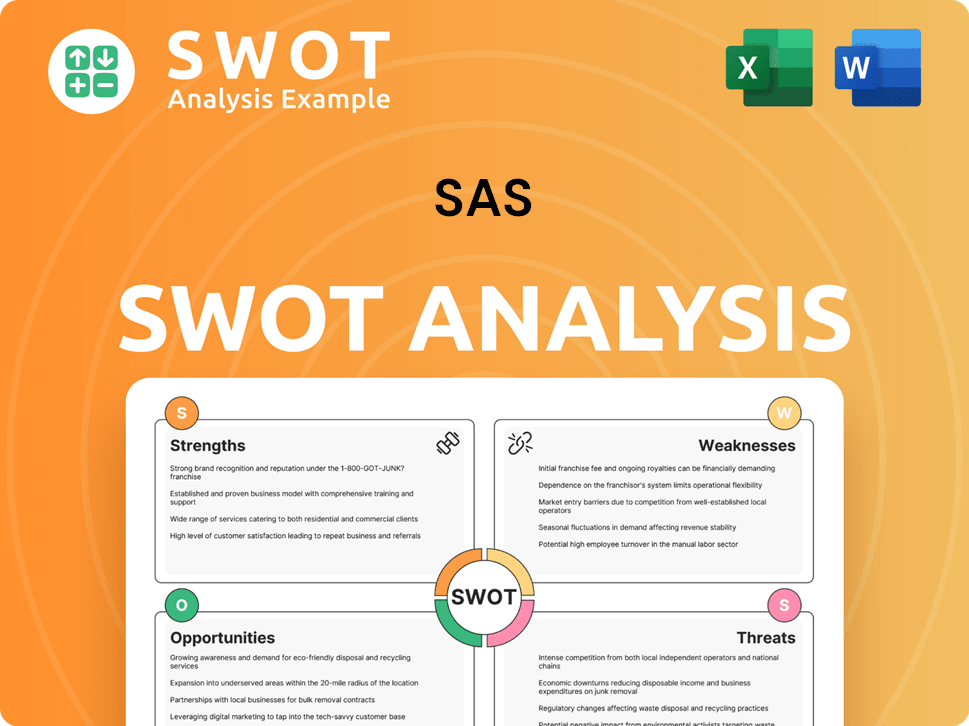
How Has SAS’s Ownership Changed Over Time?
The history of SAS Institute, a software company, is marked by its consistent status as a privately held entity. This strategic choice has allowed it to focus on long-term goals and employee welfare, rather than being swayed by the short-term pressures of public markets. A notable event was the consideration of an initial public offering (IPO) during the dot-com boom of 1999, which was ultimately rejected. This decision proved advantageous when the market experienced a downturn.
The ownership structure of the SAS company has remained relatively stable. The primary stakeholders are the co-founders, James Goodnight and John Sall. James Goodnight, the CEO, holds approximately two-thirds of the company's ownership, while John Sall, the Executive Vice President, owns the remaining one-third. This concentrated ownership gives the founders significant control over the company's strategic direction and governance. The company has consistently reinvested a significant portion of its annual revenue, around a quarter, in research and development. In 2024, the company's annual sales exceeded $3 billion.
| Key Aspect | Details | Impact |
|---|---|---|
| Ownership Structure | Privately held, primarily owned by co-founders | Enables long-term strategic focus and employee-centric policies |
| IPO Consideration | Considered an IPO in 1999 but decided against it | Protected the company during the subsequent market downturn |
| R&D Investment | Approximately 25% of annual revenue reinvested in R&D | Drives innovation and long-term growth |
It's crucial to differentiate between SAS Institute Inc. and SAS AB (SAS Group), the Swedish airline holding company. In August 2024, after exiting U.S. Chapter 11 bankruptcy, SAS AB underwent a significant ownership restructuring. The new major shareholders of the airline include Castlelake, L.P. (32%), the Government of Denmark (25.8%), Air France-KLM (19.9%), and Lind Invest (8.6%). This restructuring resulted in the delisting of SAS AB's shares, impacting existing shareholders. This information pertains specifically to the airline and not to the software company, SAS Institute Inc.
SAS Institute remains privately held, with its founders maintaining significant ownership. This structure supports long-term strategies and substantial investment in research and development.
- James Goodnight and John Sall are the primary owners.
- The company's focus is on sustained growth and innovation.
- The airline SAS AB has a different ownership structure.
SAS PESTLE Analysis
- Covers All 6 PESTLE Categories
- No Research Needed – Save Hours of Work
- Built by Experts, Trusted by Consultants
- Instant Download, Ready to Use
- 100% Editable, Fully Customizable
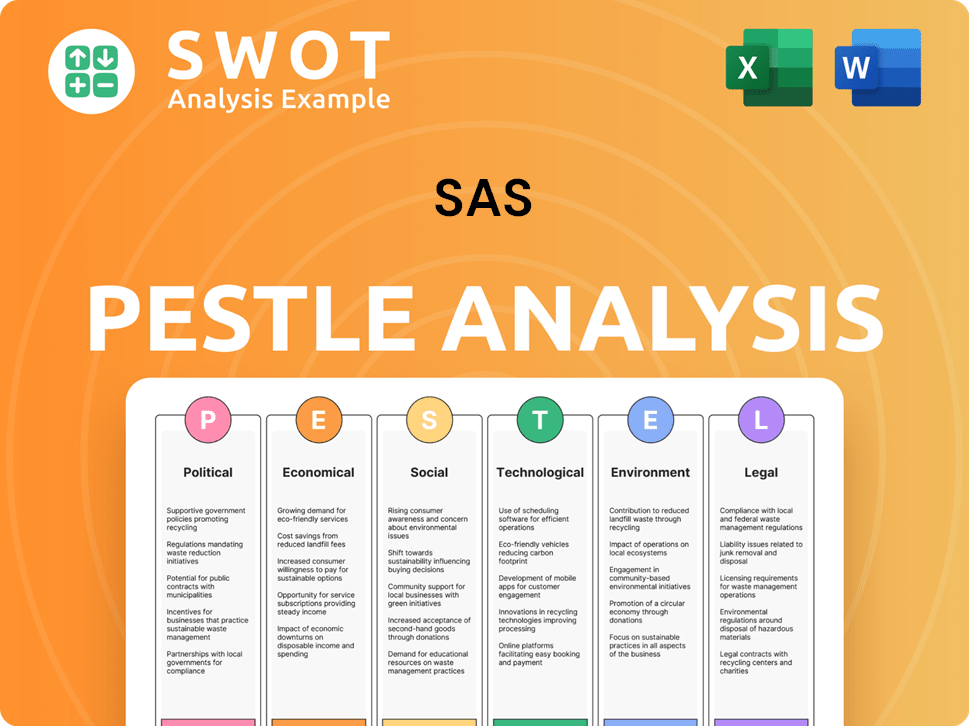
Who Sits on SAS’s Board?
As a privately held entity, the structure of the board of directors at SAS Institute Inc. differs significantly from publicly traded companies. The governance of the SAS company is primarily shaped by its founders. James Goodnight, the CEO, and John Sall, a co-founder and Executive Vice President, hold significant influence. Their substantial ownership stakes, with Goodnight owning roughly two-thirds and Sall one-third, grant them considerable control and voting power within the organization. This concentrated ownership ensures that the founders' vision and strategic direction largely dictate company decisions, minimizing the impact of external shareholders or proxy battles.
The executive leadership team, which manages the SAS company's business operations, financial reporting, and strategic initiatives, is appointed by the President in consultation with the Board of Directors. This structure emphasizes the central role of the CEO, James Goodnight, in the company's governance. The President is the primary liaison with the Board, with other executive team members reporting to the President. This setup reinforces the founders' control and influence over the SAS Institute's operations and strategic direction.
| Leadership Role | Name | Title |
|---|---|---|
| CEO | James Goodnight | Chief Executive Officer |
| Executive Vice President | John Sall | Executive Vice President |
| President | (Not Publicly Disclosed) | President |
The SAS Institute ownership structure allows for a focused approach to long-term strategic planning. The founders' significant ownership stakes provide stability and the ability to make decisions without the pressures of short-term market fluctuations. This structure supports a culture of innovation and a commitment to the SAS software's development. For more insights into the company's strategic focus, you can explore the Target Market of SAS.
SAS Institute's governance is heavily influenced by its founders, James Goodnight and John Sall, due to their significant ownership. This structure provides stability and allows for long-term strategic planning. The concentrated ownership model means that decisions are primarily driven by the founders' vision.
- James Goodnight, as CEO, and John Sall, as Executive Vice President, hold substantial control.
- The executive leadership team reports to the President, who reports to the Board.
- SAS remains privately held, which impacts its board structure and shareholder dynamics.
- The founders' ownership ensures a focus on long-term strategic goals.
SAS Business Model Canvas
- Complete 9-Block Business Model Canvas
- Effortlessly Communicate Your Business Strategy
- Investor-Ready BMC Format
- 100% Editable and Customizable
- Clear and Structured Layout
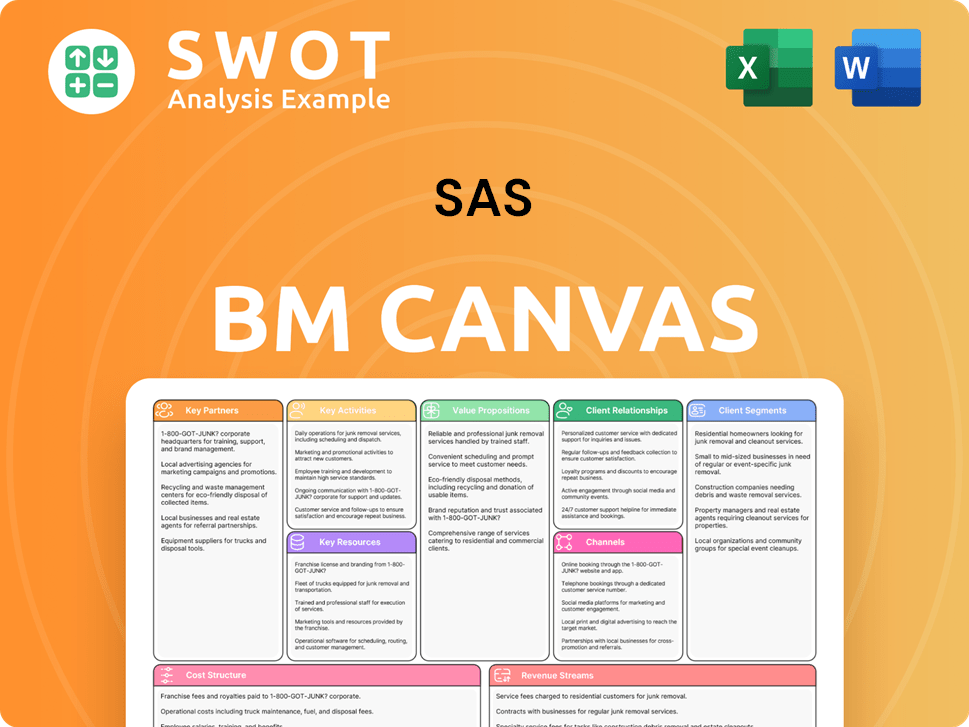
What Recent Changes Have Shaped SAS’s Ownership Landscape?
Recent developments indicate potential shifts in the ownership structure of SAS, a privately held company. In July 2021, SAS announced its intention to pursue an initial public offering (IPO) by 2024. This decision followed discussions about a possible acquisition by Broadcom, which did not proceed. The primary goal of an IPO was to offer stock options to employees to attract talent and to establish a succession plan for long-term growth.
However, the timeline for the IPO has been extended. In September 2023, CEO Jim Goodnight suggested the IPO would likely occur in 2025, citing the need for internal 'housekeeping,' including the implementation of new financial, accounting, and lead-to-cash systems, which were finalized in January 2025. More recently, in May 2025, Gavin Day, the newly appointed Chief Operating Officer, stated that SAS could wait until the company and the market were ready, possibly pushing the IPO to 2027. Day emphasized that SAS is a 'no-debt company' and does not require capital from an IPO, allowing it to be patient for optimal market conditions. You can learn more about the Growth Strategy of SAS.
| Aspect | Details | Timeline |
|---|---|---|
| IPO Intention | Announced | July 2021 |
| Original Target Date | 2024 | July 2021 |
| Revised Target Date | 2025 (likely) / 2027 (possible) | September 2023 / May 2025 |
| Reason for Delay | Internal 'housekeeping' and market readiness | September 2023 / May 2025 |
In terms of acquisitions, SAS acquired the technology of synthetic data leader Hazy in November 2024 to enhance its data management and analytics capabilities. This move aligns with industry trends focusing on advanced data solutions and AI. SAS continues to prioritize its investment in AI research and development, committing $1 billion to further AI R&D in 2019. The company's revenue for fiscal year 2024 was NT$79.68 billion, a 2.8% year-over-year decline.
SAS, a privately held company, has been exploring an initial public offering (IPO). The IPO timeline has been pushed back, with potential dates ranging from 2025 to 2027. The company is focusing on internal readiness and market conditions before going public.
SAS acquired Hazy in November 2024 to boost its data management and analytics capabilities. The company continues to invest heavily in AI research and development. SAS's revenue for fiscal year 2024 was NT$79.68 billion, a 2.8% decrease year-over-year.
The company's IPO timing depends on both internal readiness and favorable market conditions. SAS's strong financial position, being a 'no-debt company,' provides flexibility. Strategic acquisitions like Hazy indicate a focus on expanding its data analytics and AI capabilities.
SAS's revenue for fiscal year 2024 was NT$79.68 billion. The company's financial strategies include a focus on internal improvements and strategic acquisitions. The company's financial health allows for a patient approach to the IPO timeline.
SAS Porter's Five Forces Analysis
- Covers All 5 Competitive Forces in Detail
- Structured for Consultants, Students, and Founders
- 100% Editable in Microsoft Word & Excel
- Instant Digital Download – Use Immediately
- Compatible with Mac & PC – Fully Unlocked
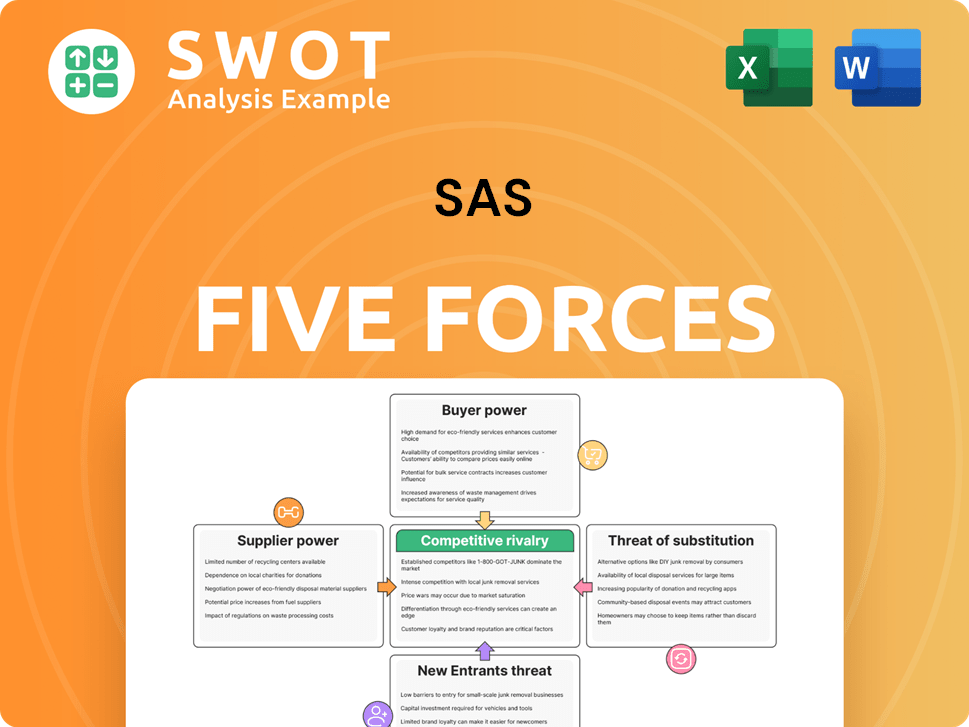
Related Blogs
- What are Mission Vision & Core Values of SAS Company?
- What is Competitive Landscape of SAS Company?
- What is Growth Strategy and Future Prospects of SAS Company?
- How Does SAS Company Work?
- What is Sales and Marketing Strategy of SAS Company?
- What is Brief History of SAS Company?
- What is Customer Demographics and Target Market of SAS Company?
Disclaimer
All information, articles, and product details provided on this website are for general informational and educational purposes only. We do not claim any ownership over, nor do we intend to infringe upon, any trademarks, copyrights, logos, brand names, or other intellectual property mentioned or depicted on this site. Such intellectual property remains the property of its respective owners, and any references here are made solely for identification or informational purposes, without implying any affiliation, endorsement, or partnership.
We make no representations or warranties, express or implied, regarding the accuracy, completeness, or suitability of any content or products presented. Nothing on this website should be construed as legal, tax, investment, financial, medical, or other professional advice. In addition, no part of this site—including articles or product references—constitutes a solicitation, recommendation, endorsement, advertisement, or offer to buy or sell any securities, franchises, or other financial instruments, particularly in jurisdictions where such activity would be unlawful.
All content is of a general nature and may not address the specific circumstances of any individual or entity. It is not a substitute for professional advice or services. Any actions you take based on the information provided here are strictly at your own risk. You accept full responsibility for any decisions or outcomes arising from your use of this website and agree to release us from any liability in connection with your use of, or reliance upon, the content or products found herein.